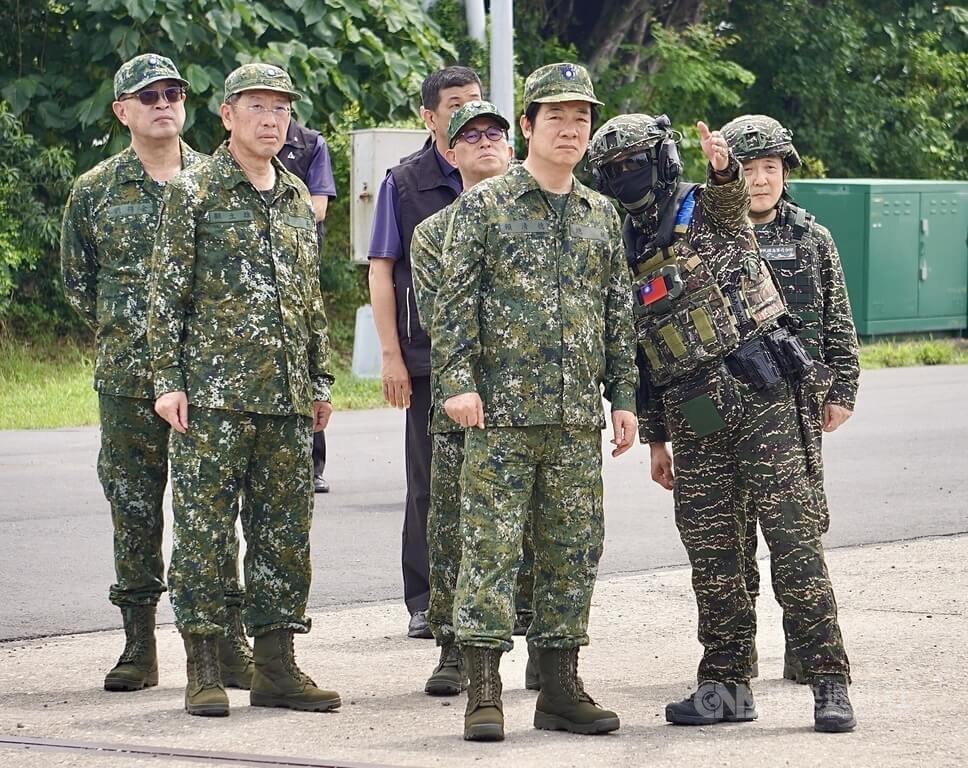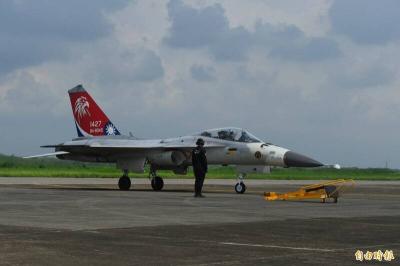The ongoing Han Kuang military drills entered their sixth day today, with units simulating repelling enemy landings in Penghu County, setting up fortifications in Tainan, laying anti-ship mines in Kaohsiung and conducting urban combat drills in Taipei.
At 5am in Penghu — part of the exercise’s first combat zone — participating units responded to a simulated rapid enemy landing on beaches, combining infantry as well as armored personnel.
First Combat Zone Commander Chen Chun-yuan (陳俊源) personally led the combined armed troops in countermeasures, utilizing a variety of weapons systems.

Photo: CNA
Wang Keng-sheng (王鏗勝), the commander in charge of the Penghu Defense Command’s mechanized battalion, said he would score the exercise “100 percent.”
Since taking leadership of the unit in May, Wang said he has followed the principle of “one day without war, one day without feeling at ease,” ensuring that participating personnel are sure of their roles.
In Tainan, the army’s 54th Engineer Group conducted a nighttime exercise in constructing defensive fortifications to block a potential enemy advance.
The unit deployed “Czech hedgehogs,” moved abandoned vehicles into the roadway and installed razor wire barricades, among other measures, to make it difficult for enemy personnel and vehicles to pass.
Some drivers who passed by the area while soldiers set up the fortifications shouted words of encouragement.
It is important to test how quickly fortifications could be erected in a low-light environment, personnel said.
The site was cleared by 5am, they added.
In Kaohsiung’s Zuoying District (左營), President William Lai (賴清德) observed a mine-laying exercise and provided personnel with extra meal money to encourage them and show appreciation for their work.
Chang Chia-ming (張家銘), from the navy’s 192nd Fleet's mine operations squadron, told the president and other officials about the three different types of mines Taiwan uses, all domestically designed and produced.
The mines target enemy surface vessels and submarines, Chang said, adding that they are a “shield” for the country.
Mines are cheap to deploy, but expensive and time-consuming to remove as an invading force, Chang said, citing historic examples such as the Korean War and the 1991 Gulf War.
In Taipei, US-imported FIM-92 Stinger shoulder-fired missiles made a rare public appearance during early-morning drills in the Taipei Metro simulating a Chinese invasion.
The exercises featured Military Police troops carrying Stingers, machine guns, 40mm grenade launchers and anti-armor rockets, and were held between Shandao Temple Station and Longshan Temple Station while the metro was closed to passengers.
The Ministry of National Defense said the exercises simulated Taiwanese troops using the metro system to quickly reach a target area and engage the enemy.
Separately, the ministry said that 17 Chinese aircraft were monitored in the airspace around Taiwan between 6am yesterday and 6am today.
Of the 17 aircraft, seven crossed the median line of the Taiwan Strait, it said.
A further eight naval vessels were also spotted in the waters around Taiwan, it added.

LOW RISK: Most nations do not extradite people accused of political crimes, and the UN says extradition can only happen if the act is a crime in both countries, an official said China yesterday issued wanted notices for two Taiwanese influencers, accusing them of committing “separatist acts” by criticizing Beijing, amid broadening concerns over China’s state-directed transnational repression. The Quanzhou Public Security Bureau in a notice posted online said police are offering a reward of up to 25,000 yuan (US$3,523) for information that could contribute to the investigation or apprehension of pro-Taiwanese independence YouTuber Wen Tzu-yu (溫子渝),who is known as Pa Chiung (八炯) online, and rapper Chen Po-yuan (陳柏源). Wen and Chen are suspected of spreading content that supported secession from China, slandered Chinese policies that benefit Taiwanese and discrimination against Chinese spouses of

ALIGNED THINKING: Taiwan and Japan have a mutual interest in trade, culture and engineering, and can work together for stability, Cho Jung-tai said Taiwan and Japan are two like-minded countries willing to work together to form a “safety barrier” in the Indo-Pacific region, Premier Cho Jung-tai (卓榮泰) yesterday said at the opening ceremony of the 35th Taiwan-Japan Modern Engineering and Technology Symposium in Taipei. Taiwan and Japan are close geographically and closer emotionally, he added. Citing the overflowing of a barrier lake in the Mataian River (馬太鞍溪) in September, Cho said the submersible water level sensors given by Japan during the disaster helped Taiwan monitor the lake’s water levels more accurately. Japan also provided a lot of vaccines early in the outbreak of the COVID-19 pandemic,

PROMOTION: Travelers who want a free stopover must book their flights with designated travel agents, such as Lion Travel, Holiday Tours, Cola Tour and Life Tours Air Canada yesterday said it is offering Taiwanese travelers who are headed to North America free stopovers if they transit though airports in Japan and South Korea. The promotion was launched in response to a potential rise in demand for flights to North America in June and July next year, when the US, Canada and Mexico are scheduled to jointly host the FIFA World Cup, Air Canada said. Air Canada offers services to 13 of the 16 host cities of the tournament’s soccer games, including Toronto and Vancouver; Mexico City, Guadalajara and Monterrey in Mexico; Atlanta, Georgia; Boston; Dallas; Houston;

The US approved the possible sale to Taiwan of fighter jet spare and repair parts for US$330 million, the Pentagon said late yesterday, marking the first such potential transaction since US President Donald Trump took office in January. "The proposed sale will improve the recipient's capability to meet current and future threats by maintaining the operational readiness of the recipient's fleet of F-16, C-130," and other aircraft, the Pentagon said in a statement. Trump previously said that Chinese President Xi Jinping (習近平) has told him he would not invade Taiwan while the Republican leader is in office. The announcement of the possible arms